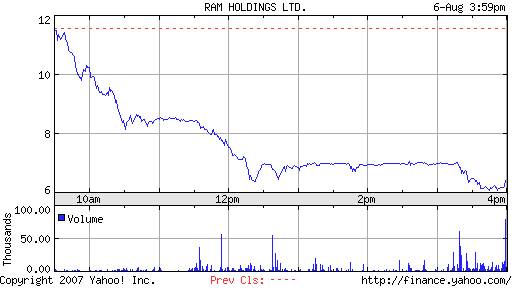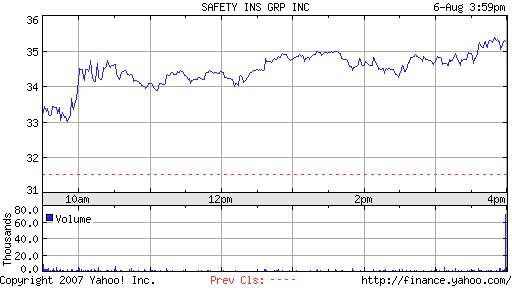The Current Market Morass
Over at RealMoney, toward the end of the day, I commented:
| David Merkel | ||
| Many Hedge Funds are Systematically Short Liquidity | ||
| 8/9/2007 5:43 PM EDT |
You can look at Cramer’s two pieces here and here that deal with the logjam in the bond markets. Now, there are problems that are severe, as in the exotic portions of the market. There are problems in investment grade corporate bonds in the cash market, but spreads haven’t moved anywhere nearly as much as they did in 2002. The synthetic (default swap) portion of the market is having greater problems. Oddly, though high yield cash spreads have moved out, they still aren’t that wide yet either compared to 2002. The problems there are in the CDS, and hung bridge loans.
Most hedge funds that try to generate smooth returns are systemically short liquidity and volatility. If these funds are blowing up, like LTCM in 1998, then liquidity will be tight in the derivative markets, but the regular cash bond markets won’t be hurt so bad.
I agree with Michael Comeau with a twist… this may end up being good for the equity markets eventually, but in the short run, it is a negative.
Let me try to expand a little more here. A good place to start is Cramer’s last piece of the day. Part of what he said was:
But first you have to recognize that I am not talking about opportunity. We need the Fed simply to issue a statement like it did in 1987, that it would provide all of the liquidity necessary to get things moving in the credit markets.
All of those who think the Fed is helpless are as clueless as the Fed. A statement like that would eliminate the fear all over town that committing capital is going to wipe your firm out.
The European action seemed desperate today, but it’s a bit of a desperate time, and they did what is right.
If we had made the right call on Tuesday at the Fed, we would have maneuverability over the next month to help.
Now we can’t. Not for another couple of months, [sic]
Unfortunately, Cramer is wrong here. The ECB only did a temporary injection of funds, which will disappear. The Fed also did a similar temporary injection of funds today, which brought down where Fed funds were trading. It will disappear as well, but both the ECB and Fed can make adjustments as they see fit. There isn’t any significant difference between the actions.
There have been notable failures and impairments, for sure. Let’s run through the list: the funds at BNP Paribas, funds at AXA, Oddo, Sowood and IKB, Goldman Sachs, Tykhe Capital, and Highbridge (and more). With this help from DealBreaker (most of the comments are worth reading also), I would repeat that most hedge funds that try to generate smooth returns are systemically short liquidity and volatility. Another way of saying it is that they have a hidden short in credit quality, and this short is biting bigtime.
Okay, I’ve listed a lot of the practical failures, but what classes of hedge fund investments are getting hurt? Primarily statistical arbitrage and event-driven. (Oh, and credit-based as well, but I don’t have any articles there.) The computer programs at many stat arb shops have not done well amid the volatility, and there have have been significant M&A deals that have come into question, like MGIC-Radian. Merger arbitrage had a bad July, and looking at the Merger Fund, August looks to be as bad. (Worrisome, because merger arb correlates highly with total market confidence.) As for statistical arb, I know a few people at Campbell & Company. They’re bright people. Unfortunately, when regimes shift, often statistical models are bad at turning points. Higher volatility, bad credit, and the illiquidity that they engender doom many statistical models of the market.
So, how bad is credit now? If you are talking about securitized products and derivatives, the answer is extremely bad. If you are talking about high yield loans to fund LBOs, very bad, and my won’t some the investment banks take some losses there (but they won’t get killed). High yield bonds, merely bad — spreads have widened, but not nearly as much as in 2002. Same for investment grade corporates, except less so. Now the future, like say out to 2010, may prove to be even worse in terms of aggregate default rates of corporates, because more of the total issuance is high yield. This is just something to watch, because it may imply a stretched-out scenario for corporate credit losses.
The Dreaded Subprime
Subprime mortgage lending has had poor results. I would even argue that early 2007 originations could be worse than the 2006 vintage. This has spilled over into many places, but who would have expected money market funds? The asset-backed commercial paper [ABCP] market is a small slice of the total commercial paper market, and those financing subprime mortgage receivables are smaller still. The conduits that do this financing have a number of structural protections, so it should not be a big issue. The only thing that might emerge is if some money market fund overdosed on subprime ABCP. I’m not expecting any fund to “break the buck,” but it’s not impossible.
I generally like the writings of Dan Gross. He is partially right when he says that the effects of subprime lending are not contained. Many different institutions are getting nipped by the problem. But I think what government officials mean by contained is different. They are saying that they see no systemic risk from the problem, which may be correct, so long as the aggregate reduction in housing prices does not cause a cascade of failure in the mortgage market, which I view as unlikely.
Perhaps we should look at a bull on subprime lending? Not a big bull, though. Wilbur Ross has lent $50 million to American Home Mortgage on the most senior level possible. That’s not a very big risk, but he does see a future for subprime lending, if one is patient, and can survive the present slump.
A note on Alt-A lending. There’s going to be a bifurcation here; not all Alt-A lending is the same. As S&P and the other rating agencies evaluate loan performance, they will downgrade the deals with bad performance, and leave the good ones alone. The troubles here will likely be as big as those in subprime. Perhaps the lack of information on lending is the crucial issue. Colloquially, never buy a blind pool, or a pig in a poke. Information is supremely valuable in lending, and often incremental yield can’t compensate.
Summary Thoughts
I think 1998 is the most comparable period to 2007. There are some things better and worse now, than in 1998. In aggregate it’s about the same in my opinion. Now with hedge funds, the leverage in aggregate is higher, but could that be that safer instruments are being levered up? That might be part of it, but I agree, aggregate leverage is higher.
In a situation like this, simplicity is rewarded. Complexity is always punished in a liquidity crisis. Bidders have better thing sto do in a crisis than to figure out fair value for complex instruments when simpler ones are under question.
Another aspect of liquidity is the investment banks. As prime brokers, their own risk control mechanisms cause them to liquidate marginal borrowers whose margin has gotten thin. This protects them at the risk of making the crisis worse for everyone else as the prices of risky asset declines after liquidations. Other investors might then face their own margin calls. The cycle eventually burns out, but only after many insolvencies. My guess: none of the investment banks go under.
Finally, let’s end on an optimistic note, and who to do that better than Jim Griffin? As I said before, simplicity is valued in a situation like this, and stocks in aggregate are simple. As he asks at the end of his piece, “What are you going to buy if you sell stocks?” I agree; there will be continued problems in the synthetic and securitized debt markets, but if you want to be rewarded for risk here, equities offer reasonable compensation for the risks taken. Just avoid the areas in financials and hombuilders/etc, that are being taken apart here. The world is a much larger place than the US & European synthetic and securitized debt markets, and there are places to invest today. Just insist on a strong balance sheet.




 I know that Cramer and many others consider the news from the Bear Stearns call to be the financial equivalent of nuclear meltdown, but it’s not true: Exhibit 1 is the graphic above from The Wall Street Journal (
I know that Cramer and many others consider the news from the Bear Stearns call to be the financial equivalent of nuclear meltdown, but it’s not true: Exhibit 1 is the graphic above from The Wall Street Journal (